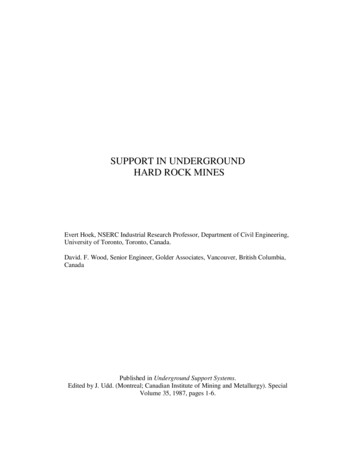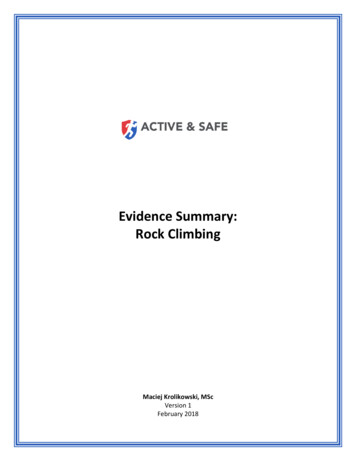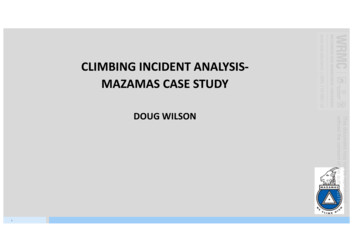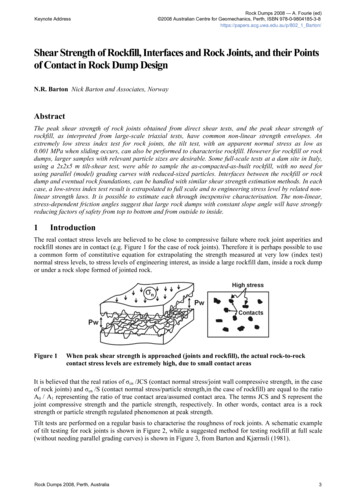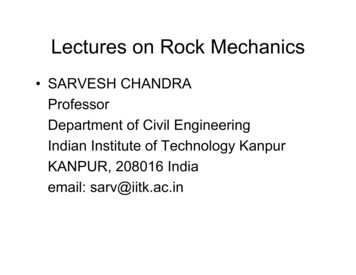
Transcription
Lectures on Rock Mechanics SARVESH CHANDRAProfessorDDepartmenttt off CivilCi il EEngineeringiiIndian Institute of Technology KanpurKANPUR, 208016 Indiaemail: sarv@iitk.ac.insarv@iitk ac in
The problem in mathematics is black and white but the realworldld iis grey –AlbertAlb t EinsteinEi t i
Rock Mechanics Problems How will rock react when pput to men’s use? What is the bearing capacity of rock on surface an atdepths? What is the shear strength of rocks? What is the response of rocks under dynamic /earthquake type loading? What is the modulus of elasticity of rock and how to getit? What are the effects of rock defects (jointing beddingplanes, schistocity, fissures, cavities and otherdiscontinuities) on its strength? What are the mechanisms of failure of rocks?
Rock as a Construction Material For laying structural foundations to supportstructures For constructingg Undergroundgopeningspg For protecting slopes For supporting railway tracks – Ballasts As base and sub-base for roads and runways As aggregate in concrete Making facia for buildings.
aceousM s z icMesozoicSilurianOrdovicianCambrian2 million5 million26 million38 millionll54 million65 million185 million230 millionPermianDevonian10 00010,000130 millionJur ssicJurassicTriassicPaleozoicTime Boundaries(Years Ago)Holocene - nianMississippian265 million310 million355 million413 million425 million475 million570 millionPrecambrian3.9 billionEarth Beginning4.7 billion
What are we calling a rock?Grade Description LithologyExcavationFoundationsVISoilSome organic content,no original structureMay need toUnsuitablesave and re-useVCompletelyweatheredDecomposed soil, someremnant structureScrapeAssess by soiltestingIVHighlyweatheredPartly changed to soil,soil rockScrape NBcorestonesVariable andunreliableIIIModeratelyweatheredPartly changes to soil,rock soilRipGood for mostsmall structuresIISlightlyg yweatheredIncreased fractures andmineral stainingBlastGood foranything exceptlarge damsIFresh rockClean rockBlastSoundEngineering classification of weathered rock
Primary Rock Types by GeologicOriginSedimentary TypesGrainClasticAspectsMetaphorphicIgneous TypesCarbonateFoliated Massive Obsidian
Index Properties of Intact Rock Specific Gravity of Solids, Gs Unit Weight,γ Porosity, n Ultrasonic Velocities ((Vp and Vs) Compressive Strength, qu Tensile Strength, T0 Elastic Modulus, ER (at 50% of qu)
Specific Gravity of Rock chloritefeldsparquartzserpentinegypsumhaliteCommon MineralsAverage Gs 2.700Reference Value(fresh water)1234567Specific Gravity of Solids,Solids Gs8
Unit Weights of Rocks3Saturated Unit Weightt, γT (kN/m )28γsat γwater [ Gs(1-n) raniteLimestoneSiltstoneTuffGs 2.802.652.50140.00.10.20.3Porosity nPorosity,0.40.50.6
Geologic Mapping of Rock MassFeatures
INHERENT COMPLEXITIES11.R k ffractureRockt 2.Size effects 3.under compressive stressesresponse of rock to loading affected by the size ofth loadedthel d d volume”l” (j(jointsi t & ffractures)t)Tensile strength is low (similar to concrete); HOWEVER a rock masscan have even less tensile strength
COMPLEXITIES .4. Groundwater effects water in joints: if under pressure, reducesnormal stress (less resistance along joints) water in permeable rocks (e.g. sandstone) soillike response softening of clay seams & argillaceous rocks (e.g.shales)
COMPLEXITIES .5. Weathering chemical/physical alteration, reduction of engineeringp pproperties limestone caverns, sinkholes: ”Karst” basic rocks with olivine ((e.g.g basalt)) and pypyroxeneminerals are reduced to montmorillonite by hydrolysis
Cavernous limestoneCoffinBay
STRUCTURAL FEATURES orDISCONTINUITIES1) Bedding planes2) Folds– tension joints at the crest of a fold (strike, dip& shears ea jojoints)s)– folding may cause shear failure alongbedding planes(axialplane or fracture cleavage)
Folding
DISCONTINUITIES3) Faults– shear displacement zones - slidingFaults may contain––––FaultFlt gouge (clay)( l ) – weakkFault breccia (re-cemented rock) – weakRock flour– weakAngular fragments – may be strong
Defects
Defects
DISCONTINUITIES4) Shear zones– bands of materials - local shear failure5) Dykes– igneous intrusions (near vertical)– weathered dykes, e.g. dolerite weathers tomontmorillonite– unweathered dykes attract high stresses6) Joints– breaks with no visible displacement
Joint Patternssedimentary rocks usually contain 2 sets ofjoints orthogonal to each other and thejoints,bedding plane
JOINTS1)) OpenpFilledHealed (or closed)2) SteppedUndulatingPlPlanar2B) each of the above can be RoughSmoothSlickensided
JOINT CLASSES(AS dedRoughSmoothSlickensided
Order of Description of Rocks(AS 1726-1993)ROCK MATERIALCOMPOSITIONrock namegrain size ((Table A6))gtexture and fabric (Table A7)coloure.g. Basalt, fine, massive, vesicular, darkgrey to black
Order of Description of Rocks(AS 1726-1993)ROCK MATERIALstrength (Table A8)CONDITIONweathering (Table A9)e.g. VL strength, XWOR EH strength, FR
Order of Description of Rocks(AS 1726-1993)ROCK MASSstructurePROPERTIESdefects (much information required)weathering of jointsStructure:sedimentarysede ta y rocksoc s – bedded, laminatedaatedmetamorphic– foliated, banded, cleavedigneous rocks– massive,massive flow banded
DEFECTS – information needed tightnessti ht cementation or infill smoothness or irregularity of surfaces class of joint water in joints joint orientation joint spacing
DESIGN IN ROCKTake into account: Local geological structure Shear strength of the rock mass Impact of water on stability RockR k anchoring?h i ? Drilling and blasting procedures Monitoring of stability– the observational method
Intact Rock HeterogeneousH t Anisotropic(soils less so) Spatial variability(soils the same) Yield mechanisms are non-linear & depend onstress level and rock type Failures are often brittle(soils strainsoften or harden past the peak strength)
Rock Masses CContaint i didiscontinuitiesti iti withith littllittle ttensileilstrength Scale effect response is dependent on stressed volume Affected by groundwater & weathering In-situ stresses difficult to estimate
Rock Masses
DEFINITIONS Dip angle, βw:the acute angle measured in a vertical plane between the lineof maximum dip in a nonnon-horizontalhorizontal plane and the horizontalplanei e 0 i.e.0 βw 9090 Dip direction, αw: the geographical azimuth measured in aclockwise direction from north ((0 )) of the vertical planepin whichthe dip angle is measured i.e. 0 αw 360
Dip AngleNorthHorizontalβwLine of maximum dip
Dip directionAzimuth is the direction of an object, measured clockwise around theobserver's horizon from North, i.e. an object due north has an azimuth of 0
Dip DirectionN thNorthHorizontalαwLine of maximum dip
Quantitative Classification of RockMass Description of Joints:Orientation, Persistence, Roughness, WallStrength ApertureStrength,Aperture, FillingFilling, SeepageSeepage,Number of sets, Block size, spacing.ISRM commission’si i ’ reporttClassification of Rock MaterialBased on Uniaxial Compressive Strength
Uniaxial CompressiveStrengthRanges for someCommon RockMaterialTermKg/cm2Schist, Silt stoneVW-W, Sandy Weak- VW 70VeryStone, Lime stoneWeak- W70-200–VW-M,Granite,Medium Strong-MSStrong MS 200200-700700 Basalt,Basalt Gneiss,GneissStrong- S700-1400 Quartzite, Marble–MS-VSMS VSVery StrongStrong VS 1400
Classification for Rock MaterialStrength
Intact Rock Classification Rock Type Geologic Formation and Age Indices:I di– Specific Gravity, Porosity, Unit Weight,WWaveVelocitiesV l iti– Strength (compressive, tensile, shear)– Elastic Modulus
What is RockMechanics?R k mechanicsRockh i isi adiscipline that uses theprinciplespc p es oof mechanicsec a cs todescribe the behaviour ofrock of engineering scale.
How to correlate the properties of rock studied inthe laboratory with in-situ properties? What in-situ test methods will pprovide actual insitu conditions and properties of rock?g pparameters are to be used for rock What designslope design? How to stabilize slopes and undergroundopenings?
I Fresh rock Clean rock Blast Sound Engineering classification of weathered rock. Primary Rock Types by Geologic Origin Sedimentary Types Metaphorphic Igneous Types Grain Aspects Clastic Carbonate Foliated Massive Intrusive Extrusive Coarse Conglomerate Breccia Limestone Cong


